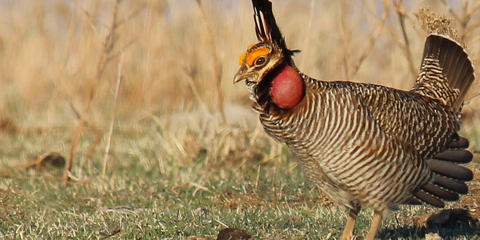Federal funding programs are under review as of 1/27/25. We'll make updates as new info is released.
Producers in Kansas, Oklahoma, New Mexico, Texas and Colorado are helping the lesser prairie-chicken rebound by voluntarily conserving habitat on their land.
NRCS offers technical and financial assistance to help agricultural producers to voluntarily conserve lesser prairie-chicken habitat on private lands. This assistance helps producers plan and implement a variety of conservation activities, or practices, that benefit the bird and agricultural operations.
Technical assistance is free to producers, through which the agency’s conservationists work side-by-side with producers to develop a conservation plan. This plan is customized the producer’s land and provides a roadmap for how to use a system of conservation practices to meet natural resource and production goals.
Financial assistance helps producers pay for the adoption of a system of conservation practices that improve the health of prairie and grassland ecosystems. NRCS assistance covers part of the cost. Common conservation practices for the lesser prairie-chicken include the removal of redcedar and mesquite and use of prescribed grazing and burning.
About the Lesser Prairie Chicken:
Best known for their dramatic courtship display, the bird depends on prairie and grassland ecosystems that have evolved under the interaction of fire and large herbivore grazing over the years.
Primarily due to large-scale loss of habitat and fragmentation of habitat, their range distribution has been reduced by roughly 85 percent. About 95 percent of the lesser prairie chicken’s habitat is privately owned, making the land management decisions of producers pivotal to the bird’s success. Stewardship-minded producers are helping the at-risk bird and many other wildlife species by voluntarily improving the health of prairie and grassland ecosystems.
Eligibility
-
Own land in Oklahoma, Texas, Colorado, Kansas or New Mexico.
-
An official tax ID (Social Security number or an employer ID)
-
A property deed or lease agreement to show you have control of the property; and
-
A farm number.
If you don’t have a farm number, you can get one from USDA’s Farm Service Agency. Typically, the local FSA office is located in the same building as the local NRCS office. You only need a farm number if you’re interested in financial assistance.
Forms
Related Programs

A Climate-Smart Strategy for the Michigan Foodshed
Star of the West Milling Company, U.S. Department of Agriculture
- Grant
- Climate-Smart
- Beginning Farmers
- Women
- MI
- Wheat
- Dried Beans
- Soybeans

A Comprehensive Evaluation of the Impact of Industrial Hemp and Soil Microalgae Consortium as High-Efficiency Carbon Sequestration Model Plants
Florida A&M University, U.S. Department of Agriculture
- Grant
- Climate-Smart
- AL
- FL
- LA
- Hemp

A Multi-Faceted Approach to Incentivizing Woody Perennial Growers to Establish Cover Crops in Orchards in Four Diverse Regions of the United States
Agoro Carbon Alliance US, U.S. Department of Agriculture
- Grant
- Climate-Smart
- CA
- WA
- OR
- MI
- FL
- Fruits
- Tree Nuts

A Vibrant Future
International Fresh Produce Association, U.S. Department of Agriculture
- Grant
- Climate-Smart
- AL
- CA
- FL
- GA
- LA
- Berries
- Grapes
- Fruits
- Vegetables
Details
Organization
Financial Instrument
Grant
Updated September 11, 2025
Image Credit: USDA
This information was gathered from public sources. Ambrook is not responsible for or able to affect the results of any financial programs listed, nor are they responsible for any incorrect information that is listed or is on the hyperlinked external sites. All information is subject to change.
Explore hundreds more programs on Ambrook.
